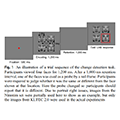Abstract
Visual working memory (VWM) for faces is facilitated when they display negative facial expressions. The present study manipulated the emotional heterogeneity of the encoding display in a change detection task to examine whether VWM is enhanced by having a separate memory store or by a bias in the allocation of limited attentional resource. When the encoding display was emotionally heterogeneous, regardless of whether happy or fearful facial expressions were presented, memory for emotional faces increased while memory for neutral faces decreased, indicating a memory trade-off. To investigate whether this occurred as a result of preferential allocation of attentional resource towards emotional expressions over neutral ones, faces were shown sequentially in different quadrants of the display. The memory trade-off between happy and neutral faces disappeared but persisted between fearful and neutral faces at trailing serial positions. When blank intervals were inserted between faces to prevent fearful faces from having prolonged processing that consumes attentional resource that should be shared with neutral faces, the memory trade-off disappeared. Findings support the argument that emotional expressions facilitate VWM due to their bias in obtaining attentional resource but the exact mechanisms through which limited resource is allocated between happy and fearful expressions may differ.
